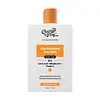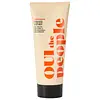What's inside
What's inside
 Key Ingredients
Key Ingredients

 Benefits
Benefits

 Concerns
Concerns

 Ingredients Side-by-side
Ingredients Side-by-side

Water
Skin ConditioningSodium Lauroyl Sarcosinate
CleansingCocamidopropyl Betaine
CleansingSodium Lauroyl Methyl Isethionate
CleansingAcrylates Copolymer
Glycol Stearate
EmollientPropanediol
SolventLactic Acid
BufferingCocamide Mea
EmulsifyingBetaine
HumectantSalicylic Acid
MaskingPhenoxyethanol
PreservativeParfum
MaskingTocopheryl Acetate
AntioxidantOryza Sativa Powder
Cellulose
AbsorbentSodium Astrocaryum Murumuruate
EmollientSodium Hyaluronate
HumectantOryza Sativa Cera
Skin ConditioningHydrolyzed Amorphophallus Konjac Root
HumectantPhospholipids
Skin ConditioningSphingolipids
EmollientSodium Hydroxide
BufferingDisodium EDTA
Water, Sodium Lauroyl Sarcosinate, Cocamidopropyl Betaine, Sodium Lauroyl Methyl Isethionate, Acrylates Copolymer, Glycol Stearate, Propanediol, Lactic Acid, Cocamide Mea, Betaine, Salicylic Acid, Phenoxyethanol, Parfum, Tocopheryl Acetate, Oryza Sativa Powder, Cellulose, Sodium Astrocaryum Murumuruate, Sodium Hyaluronate, Oryza Sativa Cera, Hydrolyzed Amorphophallus Konjac Root, Phospholipids, Sphingolipids, Sodium Hydroxide, Disodium EDTA
Water
Skin ConditioningSodium C14-16 Olefin Sulfonate
CleansingSodium Cocoamphohydroxypropylsulfonate
CleansingSodium Lauroyl Methyl Isethionate
CleansingAloe Barbadensis Leaf
MaskingLactic Acid
BufferingOryza Sativa Hull Extract
MoisturisingDaucus Carota Sativa Extract
PerfumingCitrus Limon Peel Extract
EmollientIpomoea Batatas Root Extract
Skin ConditioningChondrus Crispus Extract
Skin ConditioningVaccinium Myrtillus Fruit Extract
Skin ConditioningCamellia Sinensis Leaf Extract
AntimicrobialLactobacillus Ferment Lysate
Skin ConditioningSaccharomyces Lysate
Skin ConditioningLithothamnion Calcareum Extract
Skin ConditioningPropanediol
SolventSodium Chloride
MaskingGlycerin
HumectantCocamidopropyl Pg-Dimonium Chloride Phosphate
Cocamidopropyl Betaine
CleansingCocamidopropyl Hydroxysultaine
CleansingCocamidopropyl Dimethylamine
EmulsifyingHydroxyacetophenone
AntioxidantSorbitan Caprylate
EmulsifyingSodium Methyl Oleoyl Taurate
CleansingSodium Cocoyl Isethionate
CleansingC10-16 Olefin
Caprylyl Glycol
Emollient1,2-Hexanediol
Skin ConditioningCitric Acid
BufferingTetrasodium Glutamate Diacetate
Maltodextrin
AbsorbentBenzoic Acid
MaskingSodium Benzoate
MaskingPotassium Sorbate
PreservativeParfum
MaskingLimonene
PerfumingLinalool
PerfumingWater, Sodium C14-16 Olefin Sulfonate, Sodium Cocoamphohydroxypropylsulfonate, Sodium Lauroyl Methyl Isethionate, Aloe Barbadensis Leaf, Lactic Acid, Oryza Sativa Hull Extract, Daucus Carota Sativa Extract, Citrus Limon Peel Extract, Ipomoea Batatas Root Extract, Chondrus Crispus Extract, Vaccinium Myrtillus Fruit Extract, Camellia Sinensis Leaf Extract, Lactobacillus Ferment Lysate, Saccharomyces Lysate, Lithothamnion Calcareum Extract, Propanediol, Sodium Chloride, Glycerin, Cocamidopropyl Pg-Dimonium Chloride Phosphate, Cocamidopropyl Betaine, Cocamidopropyl Hydroxysultaine, Cocamidopropyl Dimethylamine, Hydroxyacetophenone, Sorbitan Caprylate, Sodium Methyl Oleoyl Taurate, Sodium Cocoyl Isethionate, C10-16 Olefin, Caprylyl Glycol, 1,2-Hexanediol, Citric Acid, Tetrasodium Glutamate Diacetate, Maltodextrin, Benzoic Acid, Sodium Benzoate, Potassium Sorbate, Parfum, Limonene, Linalool
Ingredients Explained
These ingredients are found in both products.
Ingredients higher up in an ingredient list are typically present in a larger amount.
Cocamidopropyl Betaine is a fatty acid created by mixing similar compounds in coconut oil and dimethylaminopropylamine, a compound with two amino groups.
This ingredient is a surfactant and cleanser. It helps gather the dirt, pollutants, and other impurities in your skin to be washed away. It also helps thicken a product and make the texture more creamy.
Being created from coconut oil means Cocamidopropyl Betaine is hydrating for the skin.
While Cocamidopropyl Betaine was believed to be an allergen, a study from 2012 disproved this. It found two compounds in unpure Cocamidopropyl Betaine to be the irritants: aminoamide and 3-dimethylaminopropylamine. High-grade and pure Cocamidopropyl Betaine did not induce allergic reactions during this study.
Learn more about Cocamidopropyl BetaineLactic Acid is another well-loved alpha hydroxy acid (AHA). It is gentler than glycolic acid but still highly effective.
Its main role is to exfoliate the surface of the skin by loosening the “glue” that holds dead skin cells together. Shedding those old cells leads to smoother, softer, and more even-toned skin.
Because lactic acid molecules are larger than glycolic acid, they don’t penetrate as deeply. This means they’re less likely to sting or irritate, making it a great choice for beginners or those with sensitive skin.
Like glycolic acid, it can:
Lactic acid also acts as a humectant (like hyaluronic acid). It can draw water into the skin to improve hydration and also plays a role in the skin's natural moisturizing factor (NMF) in the form of sodium lactate.
Studies show it can boost ceramide production to strengthen the skin barrier and even help balance the skin’s microbiome.
To get results, choose products with a pH between 3-4.
Lower strengths (5-12%) focus on surface exfoliation; higher strengths (12% and up) can reach deeper in the dermis (deeper, supportive layer) to improve skin texture and firmness over time.
Though it was originally derived from milk, most modern lactic acid used in skincare is vegan. It is made through non-dairy fermentation to create a bio-identical and stable form suitable for all formulations.
When lactic acid shows up near the end of an ingredient list, it usually means the brand added just a tiny amount to adjust the product’s pH.
Legend has it that Cleopatra used to bathe in sour milk to help reduce wrinkles.
Lactic acid is truly a gentle multitasker: it exfoliates, hydrates, strengthens, and brightens. It's a great ingredient for giving your skin a smooth, glowing, and healthy look without the harshness of stronger acids.
Read more about some other popular AHA's here:
Learn more about Lactic AcidParfum is a catch-all term for an ingredient or more that is used to give a scent to products.
Also called "fragrance", this ingredient can be a blend of hundreds of chemicals or plant oils. This means every product with "fragrance" or "parfum" in the ingredients list is a different mixture.
For instance, Habanolide is a proprietary trade name for a specific aroma chemical. When used as a fragrance ingredient in cosmetics, most aroma chemicals fall under the broad labeling category of “FRAGRANCE” or “PARFUM” according to EU and US regulations.
The term 'parfum' or 'fragrance' is not regulated in many countries. In many cases, it is up to the brand to define this term.
For instance, many brands choose to label themselves as "fragrance-free" because they are not using synthetic fragrances. However, their products may still contain ingredients such as essential oils that are considered a fragrance by INCI standards.
One example is Calendula flower extract. Calendula is an essential oil that still imparts a scent or 'fragrance'.
Depending on the blend, the ingredients in the mixture can cause allergies and sensitivities on the skin. Some ingredients that are known EU allergens include linalool and citronellol.
Parfum can also be used to mask or cover an unpleasant scent.
The bottom line is: not all fragrances/parfum/ingredients are created equally. If you are worried about fragrances, we recommend taking a closer look at an ingredient. And of course, we always recommend speaking with a professional.
Learn more about ParfumPropanediol is an all-star ingredient. It softens, hydrates, and smooths the skin.
It’s often used to:
Propanediol is not likely to cause sensitivity and considered safe to use. It is derived from corn or petroleum with a clear color and no scent.
Learn more about PropanediolSodium Lauroyl Methyl Isethionate is a cleansing ingredient. It is a surfactant, meaning it helps gather dirt, oil, and other pollutants. This helps them be rinsed away easily.
Water. It's the most common cosmetic ingredient of all. You'll usually see it at the top of ingredient lists, meaning that it makes up the largest part of the product.
So why is it so popular? Water most often acts as a solvent - this means that it helps dissolve other ingredients into the formulation.
You'll also recognize water as that liquid we all need to stay alive. If you see this, drink a glass of water. Stay hydrated!
Learn more about Water